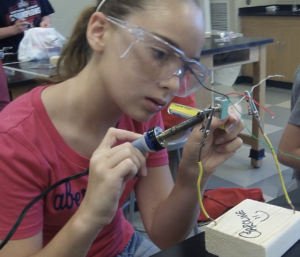Blogs | 8.27.2025
The Last Best Chance: Why Middle School is the Key to Making STEM “Cool”

I didn’t always love the science fair. My parents, both engineers, made sure my siblings and I entered every year, but I mostly went along for the ride. In 5th grade, I noticed almost no one entered the mathematics category at the fair. Seeing an easy victory, I jumped at the opportunity. With a little help from my mom, I acquired two inclinometers — one homemade, one store-bought — and used trigonometry to measure the height of buildings, testing the accuracy of my DIY mathematical tools.

It was tangible, hands-on, and surprisingly fun. I won 1st place in the district, but more importantly, something clicked. I turned from a kid who would get dragged against my will to every science fair into someone who was actively curious about the world around me. It taught me that with the right tools and a little creativity, learning could be fascinating, thought-provoking, and worth getting excited about.
As this school year kicks off, with fresh notebooks and excitement, it is a key moment for educators to consider how we approach getting students excited about STEM fields. Namely, when we focus our attention. While high school and college students have access to a growing number of STEM resources, such as advanced courses, internships, competitions, and career pathways, the middle school years often get overlooked. But this is precisely when students form the attitudes, interests, and identities that will shape their academic futures. Ignoring this stage means missing a crucial window to cultivate lasting engagement in science, technology, engineering, and math.
Why Middle School Matters So Much
Middle school is often treated as a transitional period; an academic waiting room between the foundational years of elementary school and the “real work” of high school. But in reality, it’s one of the most pivotal stages in a student’s development. At this age, students are old enough to engage in real-world problem solving and develop complex ideas, but they’re still open to discovering new interests. It’s a developmental sweet spot. Curiosity is high, identities are still forming, and peer pressure hasn’t yet fully eclipsed personal passions. It’s also a time when kids begin toask the big questions: Who am I? What am I good at? Where do I fit in?
 Ironically, this period of cognitive growth is also when interest in science starts to drop off. Research shows that many middle schoolers begin to drift away from STEM due to a combination of psychological changes — decreasing motivation, dips in self-efficacy, and uncertainty about identity. They start deciding whether or not they’re “science people,” and far too many opt out before they’ve really had a chance to explore.
Ironically, this period of cognitive growth is also when interest in science starts to drop off. Research shows that many middle schoolers begin to drift away from STEM due to a combination of psychological changes — decreasing motivation, dips in self-efficacy, and uncertainty about identity. They start deciding whether or not they’re “science people,” and far too many opt out before they’ve really had a chance to explore.
This makes middle school the last good chance to foster a genuine love of STEM and a lifelong curiosity about the world. Once students hit high school, attitudes tend to solidify, and the window to make science “cool” starts to close.
The Challenges of STEM in Middle School
If middle school is so important, why isn’t STEM already a cornerstone of the curriculum at that level? In short: it’s complicated.
STEM, by nature, is interdisciplinary. Real-world problems don’t come neatly packaged as “math” or “science,” they require collaboration across subjects. But middle school classrooms, constrained by traditional schedules and rigid curriculum standards, often aren’t set up for this kind of learning. Teachers can also feel underprepared or unsupported in creating open-ended, project-based lessons, especially when time is limited and STEM must compete with other priorities.
What Actually Works?
Despite the obstacles, there are clear models that show what does work. A study by the Journal of Science Education and Technology found that middle school students respond most positively to STEM activities that are:
- Interactive and tangible: They want to do, not just listen.
- Connected to their own lives and families: Think making a biodiversity chart of your backyard or designing solutions for community issues.
- Supportive of collaboration and creativity: Group projects that encourage teamwork and problem-solving.
One successful example is after-school robotics programs, where students can see the direct impact of their work and feel a sense of ownership over the results. Another is school-to-home energy monitoring projects, which blend science and responsibility in ways that make learning feel both real and important.
 This is where organizations like Challenger Center shine. Our immersive, hands-on Missions aren’t just fun, they’re rooted in research about what middle schoolers need to stay engaged with STEM. The Missions are collaborative, real-world, and designed to spark the exact kind of identity-building that keeps students invested in learning. These types of activities help students form a positive STEM identity. They begin to see themselves as “science people.” And that matters. A lot.
This is where organizations like Challenger Center shine. Our immersive, hands-on Missions aren’t just fun, they’re rooted in research about what middle schoolers need to stay engaged with STEM. The Missions are collaborative, real-world, and designed to spark the exact kind of identity-building that keeps students invested in learning. These types of activities help students form a positive STEM identity. They begin to see themselves as “science people.” And that matters. A lot.
So What Should We Do?
Middle school is not just a bridge between childhood and adolescence. If you’re a teacher, parent, or school administrator, make middle school STEM a priority. Give students hands-on, real-world experiences. Let them build, explore, question, and create. And if you’re looking for a place to start, take them to a Challenger Learning Center. You just might change the trajectory of their future.
After all, that scrappy 5th grade project wasn’t just a science fair win, it was a turning point. It made STEM feel real and it planted a curiosity that’s still with me today. I’m now in college, still chasing answers, still loving the process of learning, and it all started with a homemade inclinometer, a little trigonometry, and the right encouragement at just the right time. Imagine what could happen if more students had that chance.
